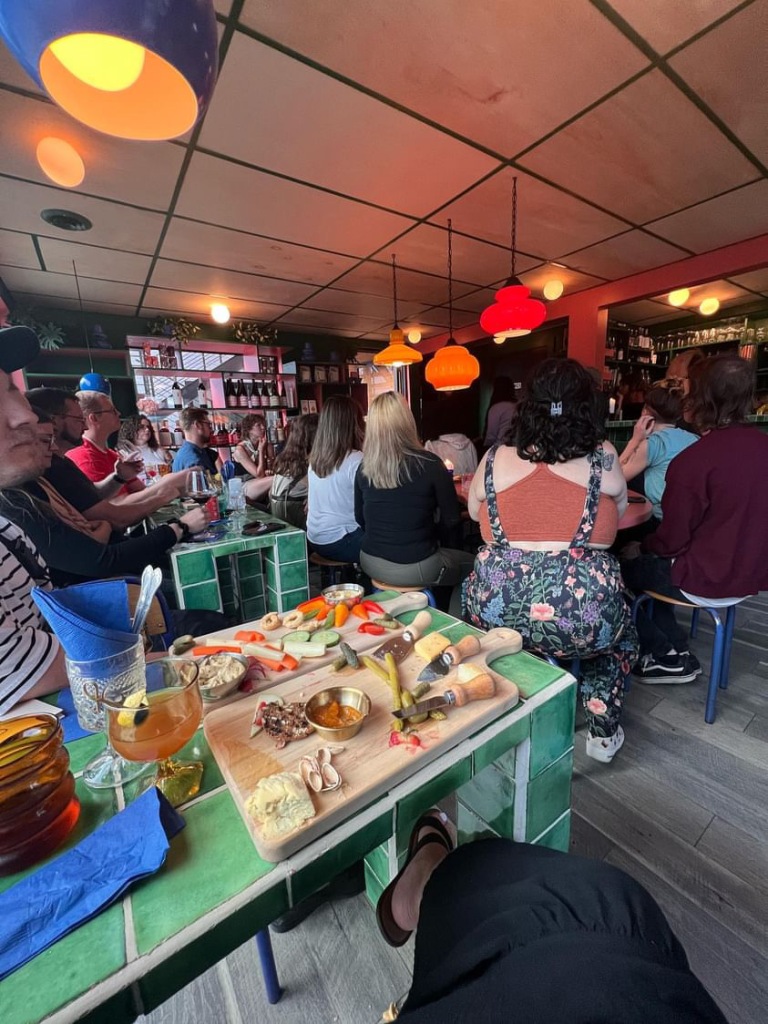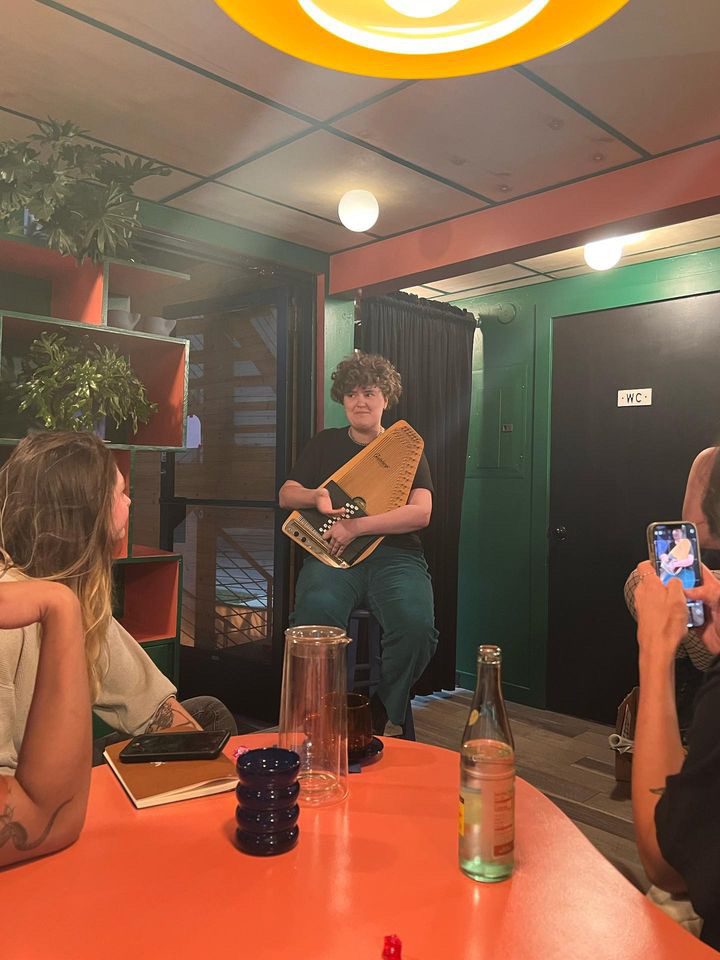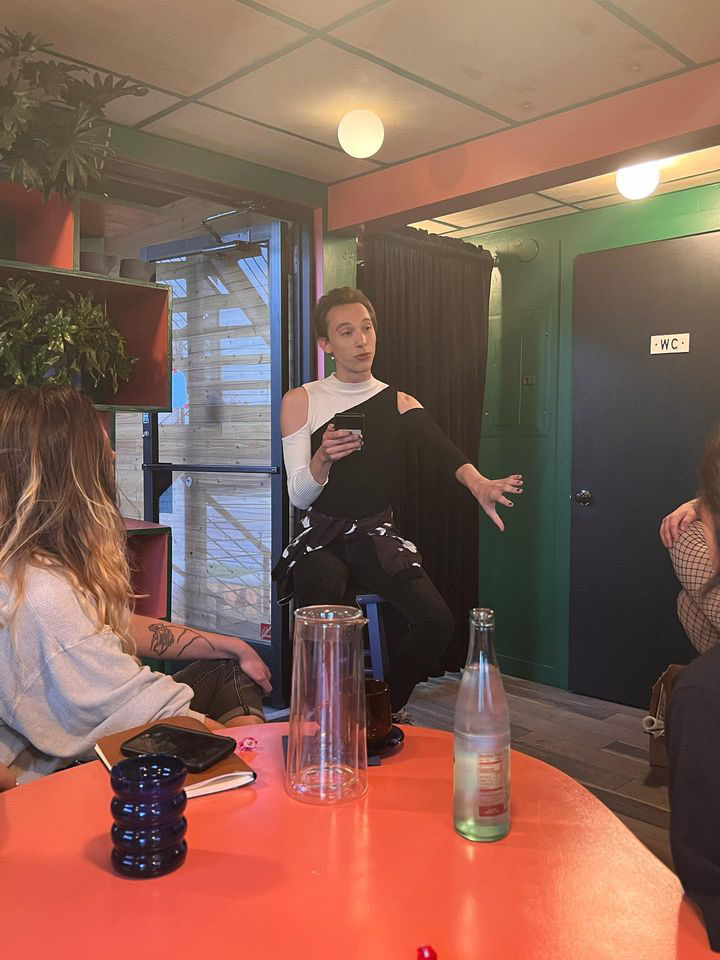week 34 of at large newsletter, playlist week 204
originally published on at large
Virginia Ahrens’ 1930s erotic fashion drawings now archived
by genevieve vahl
Mindy Brancamp was redecorating her living room in 1995 when she remembered her Grandma Virginia’s old sheet music would look perfect over the piano. She was leafing through the music in a box she had from after her grandma died in 1978, boxes untouched for over 15 years. Mindy wanted to frame a couple of the old sheets when she came across something beyond the staff. A folder of delicate sketches of women and bosom, fashion sketches, of the racy sort. Perky breasted ladies with tiny waists wearing chiffon gowns of the 1930s. Nipples pointed, coochies framed by windows in their sheer skirts. Sexy cosplay, ball gown costume design sketches, if you will. On thin paper of decades past. Eyes widened a bit, Mindy had no idea what she had come across, stunned by the life unknown of her grandma, Virginia Ahrens.
Shortly after the discovery, Mindy returned to nursing school. She always chose art classes as her electives, finding herself in one with professor Jay Salinas. He asked the class to write about an artist, any artist. Mindy asked if her grandma counts. Certainly. Any artist. Mindy had kept all of the hidden pieces, with an inkling there was something historically significant held in these drawings, much less the nostalgic significance being her grandmother’s, someone of great importance to Mindy.
The way Mindy wrote about line and gesture and the delicacy of her grandmother’s work caught Salinas’ attention, especially since she was a nursing student, making him curious if the work was as convincing as her words. And they were. But they left Salinas questioning if the drawings were “revealing something historically significant or revealing someone’s private kink.” The two sat on the work for several more years.
But the drawings never lost Salinas’ attention. He reached out to Mindy again in the year 2000, potentially looking to exhibit the body of work. The drawings showed in a couple of exhibits around the Midwest through 2002 but were “taken out of frames for storage and Virginia was on hold while families were raised and life went on,” Mindy wrote.
Salinas eventually brought the body of work to Portrait Society Gallery of Contemporary Art director Deb Brehmer, a writer, curator and art historian. To which they concluded the body of work is, in fact, quite significant. “Don’t keep that stuff bottled up,” Salinas said. The decades-long deliberation is now culminating in all 134 drawings archived in a recently published artist book in conjunction with the show of the same name: Virginia Ahrens: Trop d’Amour (Too Much Love).
…
The youngest of five growing up in Prairie du Chien, rural western Wisconsin in the 1930s, a sheltered upbringing could have easily caught Virginia in the throes of Midwestern country life. It was in high school when she began to keep diaries and draw her secret erotic fashion designs. Her first drawing is dated January 7, 1930 when she was 16 years old.
In later diaries she recounts outings to Chicago often, to the World’s Fair, with several older men she met while visiting her sister in the Windy City, offering some cultural enlightenment beyond small town Wisconsin. She also frequented the movie theaters, seeing films multiple times a week, gaining a cultural idea of sexy from the pre-Hays laws where there was no limit on profanity or nudity at the time. Perfect inspiration for her own racy fantasies of sexual expression. Taking inspiration from actresses like Jean Harlow, Marlene Dietrich and Joan Crawford. Virginia was never formally trained in art based on the journals and memory from family, but she used magazines like Vogue, Butterick Simplicity sewing patterns, newspaper fashion ads and the popular sheet music in which these were found as reference.
In 1934, she married at the age of 20, designing and sewing her own wedding dress. The dress was on display at the exhibit, hanging on the wall with timeless cuts and lace, still holding up to contemporaries. The dress “serves as a symbol of her transition from a young woman with dreams of a glamorous life into the more conventional role of wife and mother,” Brehmer wrote in her essay for the book. Both Leonard (Lennie), Virginia’s husband, and Virginia herself were always “dressed to the nines,” recounts Mindy of her grandparents. Fashion was super important to them, considering her farm upbringing, it was a way out of her family’s status quo.
Virginia used her drawings as creative output of her feminine mystique and “probable interest in women,” Mindy said. During a time when women outside the home, women’s sexuality and gayness were all highly taboo. These images were found hidden amongst her old sheet music after all, to which her husband may or may not have ever known of.
Women were relegated to homemaking and child rearing, where women’s sexuality remained in the context of motherhood. Not quite sexy. Yet this body of work from 1930 to 1946 admonishes shame, bolsters women’s bodies and sexuality and brings the female body out of the male gaze. “Women are more than just mothers,” Mindy said of what she wants viewers to take away from these drawings during the book launch event at PSG in July. “How do we keep this type of creativity going once women have children and are in marriage?”
Another woman at the book launch posed: “Why can’t she be sexual and a church goer?” Virginia sang in church, taught Sunday school, yet still found rightness in her elicit drawings. Why can’t she be both? Why can’t a church goer be a gay woman? Why can’t a Sunday school teacher have desire and sensuality? “Women weren’t supposed to be talking about their sensuality, so they hid it,” another woman from the crowd offered. “Even though it’s been there since Eve.”
Society was not hip to these notions of identity, and Virginia herself was one of the many caught in the feminine mystique, feeling isolated and alone in what has now become known as common experience amongst women at that time. Women in the crowd at the talk-back shared how their
grandmothers were over the top about their sexualities too, during this exact age bracket. “The women were there, we just don’t have a cultural record of it,” Brehmer said.
Each piece is titled, dated and notated in delicate cursive lost to newer generations. With many titles alliterated to catchy, kitschy names: “Vacation Variety,” “Daring Dancing Designs,” “Fantastic Fashions in Chiffon.” Cursive decorates the negative space in descriptions of her vision if the outfits were to be executed. “White cape knit and breast pieces, held with silver chains, fastened with rhinestones.” Rendering different weights of fabric with informed precision, clearly drawn by a versed seamstress.
Virginia’s women were active and socializing, embodying their sexuality, embracing their bodies, liberated and free. In the piece “At the Sexspray Swim Club,” women only occupy the swimming hole wearing traditional high waisted and extra long swimwear of the time. But instead of coverage for modesty, these are essentially bondage suits framing their pleasure points. Women hanging out with boobies and coochies in full display, as if nothing was out of the ordinary.
These images seek to be sexual, to sexualize women, but to do it within their means. To reclaim the woman’s body in imagery. To bring sexual identity to women beyond subordination, beyond motherhood. Pearls are strung between the crests of women’s breasts, lace and chiffon, satins and velvets, very little solid fabric. Cuts of the garments frame women’s coochies like leaves to a flower.
White skinny bodies were idealized, especially during this flapper era, as all of Virginia’s women were big breasted and tiny waisted. The fantasy in which Virginia fed. Yet, one of her pieces renders the legs of a lineup of ladies of varying widths, all wearing pumps, the one recognition of varying body types.
Photos of young Virginia share the dare of her drawings, sticking her bum and legs out of a moving car window in summertime bliss, gushing with fun. Her drawings then are almost ironic self-mockery, yet highly serious in their outlet of desire. Virginia as playful as the titles and creative as the designs. Yet desires she knew she could never act on. Her last composition is dated 1946 when she was 32.
Her decades-long queer suppression as well as loneliness from her husband being away on business all the time is hypothesized to correlate directly to Virginia’s turning to the bottle, facing a steep decline with alcoholism, dying when she was only 64 in 1978 from an alcohol related fall. Mindy remembers the end filled with her grandfather’s frustration and her grandmother’s drunken oblivion. “It was a sad ending to a woman with such potential,” Mindy said.
…
Virginia hid these drawings for decades, her family finding them decades even later. Seeming as though she felt alone, isolated in these desires for women, for their bodies, her longing transferred to the page. A classic example of the feminine mystique of the time: women having similar experiences of isolation and resentment to the social cards they were dealt in their era. Where the unexpurgated published journals of Anaïs Nin feel like the written counterparts to Virginia’s sketches. Women of the 1930’s experiencing a sexual renaissance, a post-war revival of their bodies and roles they see themselves fulfilling. Both using their creative expression to break out of the social construct they were to mold. Expressing sensuality and explicit sexual desires for women. Using language and imagery long before sex positivity entered the mainstream.
Yet that is the myth of the feminine mystique: we think these are isolated incidents, one in Prairie du Chien, Wisconsin and another across the world in Louveciennes, France. But that’s exactly the mystique of it all, that there were women everywhere during this time experiencing these sexual revolutions, awakenings, a renaissance of identity and sensuality. “The women were there, we just don’t have a cultural record of it,” because not everyone had the creative output or dare to create such explicit work questioning the status quo of the time like Virginia or Anaïs. Both depict assertive women, those who dared to bolster their bodies regardless of social cues. Confidence radiating, nudity enthused, bodies explored in the context of women doing so amongst one another. Agency brought back to their own bodies.
Brehmer talked with LGBTQ+ scholar Jonathan Katz on the significance of Virginia’s transgressive work. “Female erotic agency, especially for lesbians, was exceedingly rare in the period, and in rural Wisconsin, practically unprecedented,” Brehmer wrote of Katz’s interview, recognizing this body of work as a unique historic archive on a national scale.
In Virginia’s journals, scandalous moments were written in French, not great French that is, so her Protestant, moral-code-abiding parents couldn’t read the juice if they, god forbid, ever came across the entries. And when things got especially steamy, Virginia would repeat the phrase, trop d’amour, too much love.
…
All 134 drawings are archived in the recently published artist book as the drawings are now being sold individually. Brehmer recruited Barb Paulini to design the book, printing with The Fox Company, Milwaukee. Yet even in 2023, the binder Fox Company normally uses refused to print the book because it was “too sexy,” Brehmer said. So a new binder was found. Mindy Brancamp wrote the introduction with an essay by Brehmer. “With an appropriate see-through (chiffon-like) cover, it also includes a numbered, limited edition print,” editioned at 100. You can buy the book online on PSG’s website or stop in to the gallery to pick up a copy.










